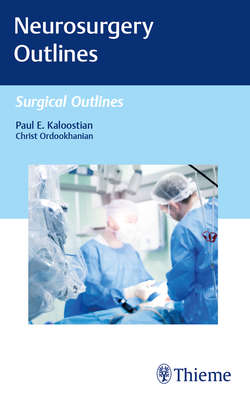Читать книгу Neurosurgery Outlines - Paul E. Kaloostian - Страница 43
На сайте Литреса книга снята с продажи.
Treatment Options
Оглавление• Conservative observation
• Radiation treatment:
– Conventional radiation: not very effective therapy
Fig. 1.17 (a–g) Radiology revealed an upper cervical intradural arteriovenous fistula (AVF) with an aneurysm in a teenage girl. Several feeding vessels were identified at the fistula. The fistula was surgically treated after reducing its blood flow by placing a coil in the main feeding artery. (Source: Operative procedure. In: Macdonald R, ed. Neurosurgical Operative Atlas: Vascular Neurosurgery. 3rd ed. Thieme; 2018).
Fig. 1.18 (a–e) Radiology revealed a cervical diffuse intramedullary arteriovenous malformation (AVM) in a teenage boy. Feeding vessels were identified to be from the anterior spinal artery and muscular branches. (Source: Relevant anatomy and classification. In: Spetzler R, Kalani M, Nakaji P, eds. Neurovascular Surgery. 2nd ed. Thieme; 2015).
Fig. 1.19 (a, b) Preoperative angiography revealed an unresectable type 2 cervical arteriovenous malformation (AVM). Postoperative angiography (24 months) demonstrates successful treatment of nidus via stereotactic radiosurgery. (Source: Stereotactic radiosurgery of spinal arteriovenous malformations. In: Nader R, Berta S, Gragnanielllo C, et al, eds. Neurosurgery Tricks of the Trade: Spine and Peripheral Nerves. 1st ed. Thieme; 2014).
Fig. 1.20 (a, b) Preoperative angiography and magnetic resonance imaging (MRI) revealed cervical intramedullary arteriovenous malformation (AVM), commonly referred to as glomus AVMs. Postoperative angiography demonstrates successful treatment of AVM. (Source: Spinal intramedullary arteriovenous malformations. In: Albright A, Pollack I, Adelson P, eds. Principles and Practice of Pediatric Neurosurgery. 3rd ed. Thieme; 2014).
– Stereotactic radiosurgery and radiotherapy (nidus must not be greater than 3 cm in diameter)
• Surgery:
– Microsurgical resection
– Preferred option if bleeding or seizures result from lesion
• Endovascular embolization using the following embolic agents (initial procedure to facilitate surgery):
– Coils: close down vessel supplying AVM (cannot independently treat AVM nidus)
– Onyx: solidifies, forming a cast, in vessel supplying AVM (best penetration of AVM nidus)
– NBCA: solidifies as a glue in vessel supplying AVM (greater risks and worse outcomes than with Onyx)
Fig. 1.21 (a–f) Magnetic resonance imaging (MRI) revealed an arteriovenous malformation (AVM) at C2–C3 in a middle-aged woman. Cyberknife treatment was performed, reducing the AVM’s total volume by 75%. Residual AVM was treated with radiation (15 Gy in two fractions). (Source: Conclusion. In: Dickman C, Fehlings M, Gokaslan Z, eds. Spinal Cord and Spinal Column Tumors. 1st ed. Thieme; 2006).
– PVA: used prior to craniotomy or surgical resection of AVM (cannot independently treat AVM pathology)
• Combination techniques:
– Embolization followed by stereotactic radiosurgery
• Venous angiomas should not be treated unless certainly contributing to intractable seizures and bleeding
